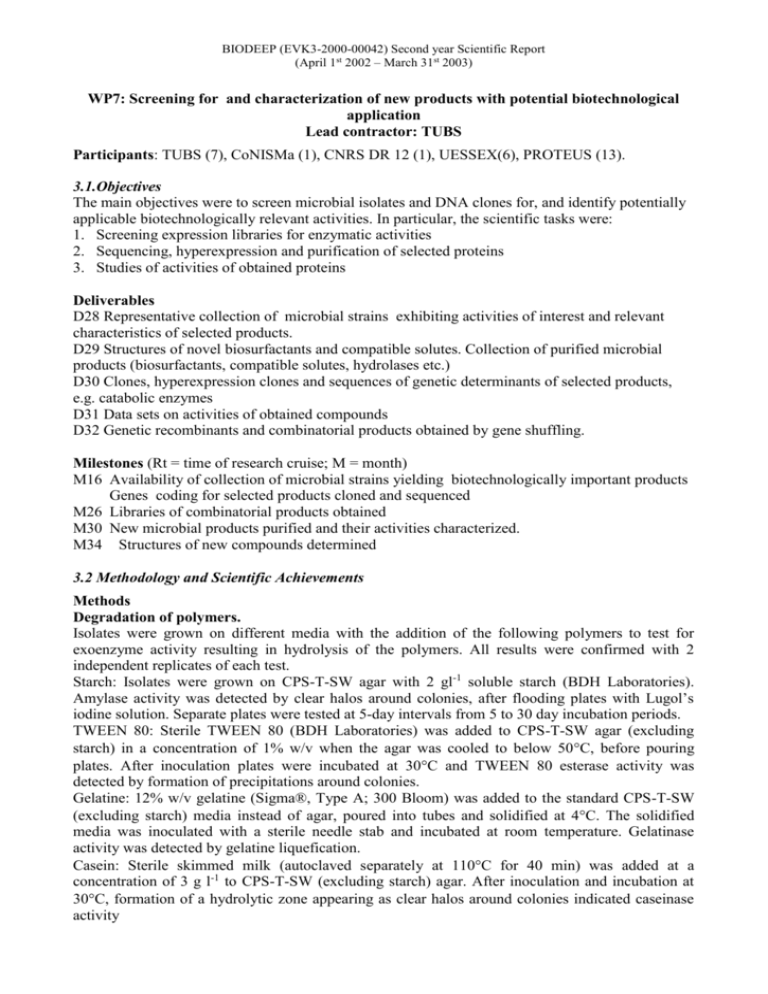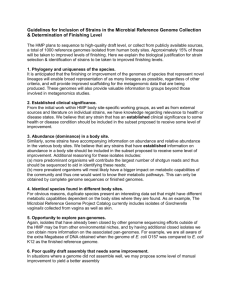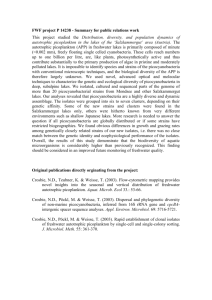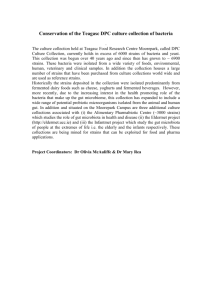WP7 - Biodeep
advertisement

BIODEEP (EVK3-2000-00042) Second year Scientific Report (April 1st 2002 – March 31st 2003) WP7: Screening for and characterization of new products with potential biotechnological application Lead contractor: TUBS Participants: TUBS (7), CoNISMa (1), CNRS DR 12 (1), UESSEX(6), PROTEUS (13). 3.1.Objectives The main objectives were to screen microbial isolates and DNA clones for, and identify potentially applicable biotechnologically relevant activities. In particular, the scientific tasks were: 1. Screening expression libraries for enzymatic activities 2. Sequencing, hyperexpression and purification of selected proteins 3. Studies of activities of obtained proteins Deliverables D28 Representative collection of microbial strains exhibiting activities of interest and relevant characteristics of selected products. D29 Structures of novel biosurfactants and compatible solutes. Collection of purified microbial products (biosurfactants, compatible solutes, hydrolases etc.) D30 Clones, hyperexpression clones and sequences of genetic determinants of selected products, e.g. catabolic enzymes D31 Data sets on activities of obtained compounds D32 Genetic recombinants and combinatorial products obtained by gene shuffling. Milestones (Rt = time of research cruise; M = month) M16 Availability of collection of microbial strains yielding biotechnologically important products Genes coding for selected products cloned and sequenced M26 Libraries of combinatorial products obtained M30 New microbial products purified and their activities characterized. M34 Structures of new compounds determined 3.2 Methodology and Scientific Achievements Methods Degradation of polymers. Isolates were grown on different media with the addition of the following polymers to test for exoenzyme activity resulting in hydrolysis of the polymers. All results were confirmed with 2 independent replicates of each test. Starch: Isolates were grown on CPS-T-SW agar with 2 gl-1 soluble starch (BDH Laboratories). Amylase activity was detected by clear halos around colonies, after flooding plates with Lugol’s iodine solution. Separate plates were tested at 5-day intervals from 5 to 30 day incubation periods. TWEEN 80: Sterile TWEEN 80 (BDH Laboratories) was added to CPS-T-SW agar (excluding starch) in a concentration of 1% w/v when the agar was cooled to below 50C, before pouring plates. After inoculation plates were incubated at 30C and TWEEN 80 esterase activity was detected by formation of precipitations around colonies. Gelatine: 12% w/v gelatine (Sigma®, Type A; 300 Bloom) was added to the standard CPS-T-SW (excluding starch) media instead of agar, poured into tubes and solidified at 4C. The solidified media was inoculated with a sterile needle stab and incubated at room temperature. Gelatinase activity was detected by gelatine liquefication. Casein: Sterile skimmed milk (autoclaved separately at 110C for 40 min) was added at a concentration of 3 g l-1 to CPS-T-SW (excluding starch) agar. After inoculation and incubation at 30C, formation of a hydrolytic zone appearing as clear halos around colonies indicated caseinase activity BIODEEP (EVK3-2000-00042) Second year Scientific Report (April 1st 2002 – March 31st 2003) Cellulose: 1% w/v low viscosity carboxymethyl cellulose (Sigma®) was added to CPS-T-SW (excluding starch) agar, which was inoculated and incubated at 30C for 10 days. Cellulase activity was detected by a hydrolytic zone appearing as halos around colonies, after flooding plates with 1 g l-1 Congo red (Sigma®) dye. Chitin: Ground chitin (50g) from crab carapaces was dissolved by stirring for one hour in 2.5l of 32% HCl. The solution was filtered via a cloth before adding sufficient RO H2O (approximately 20 l) to precipitate the chitin. The precipitate was washed by centrifugation, until a neutral pH was obtained. The prepared chitin (0.5 g l-1) was added to CPS-T-SW (excluding starch) agar, and added as an overlay medium on top of standard CPS-T-SW medium, which was inoculated and incubated at 30C. Chitinase activity was detected by a hydrolytic zone appearing as clear halos around colonies. DNA: isolates were incubated at 30C on DNase Test Agar (Merck) with added NaCl (19.42 g l-1). Plates were flooded with 1M HCl after 3 days and DNase activity was detected by a hydrolytic zone appearing as clear halos around colonies. Hydrolytic/esterase activities: Ester CLIPS-O™ substrates were used by Proteus-developed screening system to identify esterase-active isolates, along with alpha-naphtyl fatty acids derivatives (R-/S-menthylacetate, - hydroxybutyrate, -neomenthylacetate, -menthylmandelate etc.) to screen the expression lambda library clones (TUBS) and on saturated and unsaturated long chain fatty acids, adding respectively tween 60 or tryolein to a minimal solid medium (CoNISMa). Metagenomic (expression) libraries were established using Lambda Zap® Expression system (Stratagene) (TUBS) and pUC19 cloning vector (CNRS DR12). Degradation of crude oil has been tested by inoculation of washed microbial cells on mineral medium containing crude oil as unique carbon source, and after a period of incubation, active cells have been revealed by iodoniltetrazolium violet staining: strains able to grow utilizing oil as carbon source have degradative potential. Exopolysaccharides were precipitated from the strains culture broth by adding two volumes of acetone. Antibacterial activity was tested against Sarcina lutea inoculated as an overlay over the microbial cultures preventively grown on solid media and killed with ether vapours; after incubation, positive activity was considered when around the microbial colony an halo of inhibition of the growth of S. lutea was created. Scientific achievements TUBS: Eight additional clones (totally, including previous period, 11 clones), expressing hydrolases and esterases were obtained. All the amino acid sequences deduced from the DNA sequences exhibited a low similarity to the known protein families and enzyme classes. A number of these enzymes were expressed from own promoters in E.coli and exhibited expected activities (Fig. 1). The molGC% of the cloned DNA fragments varied between 33 and 68 %, a.a. similarity/identity to the known/deduced databases’ proteins was max.30/20 %, respectively. All these proteins were expressed, their activities studied (Appendix 1, Table 1a-c). Some of the enzymes appear to have a high resistance to the Na-concentration, and have even optima at high salinity, indicating that they could be extracellular enzymes working in such environments, the others were very osmosensitive, considering those were intracellular ones. A number of potential industrial applications have been identified, among them ability to hydrolyse methyl 3-hydroxybutyrate, pantolactone, dihydro-5hydroxymethyl-2(3H)-furanone and others (for example, Table 1b and 1c of Appendix 1). CoNISMa: The collection of 95 aerobic isolates obtained from water/brine interface, brine/sediment interface and sediments of the four DHABs inoculated during the 2001 Urania cruise, have been screened for several different metabolic activities: crude oil degradation, esterase activity on long chain saturated and unsaturated fatty acids, production of exopolysaccarides, and antibacterial activity. The results of the screening showed that 56% of the strains had at least one of the tested BIODEEP (EVK3-2000-00042) Second year Scientific Report (April 1st 2002 – March 31st 2003) activities, with variable degrees of intensity. We propose as interesting strains for potential biotechnological applications, the strains showed the strongest degree of activity, summarised in table 2, that could be further characterised. All the tests revealed positive strains, except for antibacterial activity, for which all the 95 strains were negative. Selected strains belonging to different phylogenetic groups from the 95 aerobic isolates collection have been preliminary tested for biotransformation activity. A total of twelve isolates have been screened for hydrolysis and/or reduction of a family of test molecules (Fig 2, Appendix 1) harbouring different substitutions, which are intermediate of drugs biosynthesis. Thin layer chromatography results revealed that several strains modified the test molecules producing one or two different modification products (Table 3). CNRS DR12 The strains isolated from 2001 cruise were physiologically characterized (see WP4 and 5). Several appeared to be susceptible to present a biotechnological interest : 10 were resistant to high salt concentration, and 16 appeared to possess extracellular enzymes (esterase, lipase, amylase, cellulase, chitinase, protease etc.) active at 100 g/l NaCl. Several DNA libraries in E. coli made in pUC18 vector were screened on a synthetic medium containing glucose as the sole carbon source, ampicillin and 50 g/l NaCl. A total of 165,000 clones, which represented approximately 880 Mb of genomes, were screened (Table 4, Appendix 1). No interesting clone was obtained. Resistance to high salt concentration is often mediated by the biosynthesis of compatible solutes, which generally implies genes organized in operon. The size of DNA inserts in our libraries was comprised between 3 and 8 kb, which is probably not sufficient to contain a whole operon. This could be a good strategy to look for new systems of resistance to high salt, but also explain the fact we didn’t obtain any interesting clone. Our work will next focus on enzymatic potential, and particularly on proteolytic and lipolytic activities. UESSEX has isolated 253 strains; 210 isolates were aerobic or facultatively anaerobic, and have been sent to Proteus and TUBS for biotechnological screening; 43 strains were strictly anaerobic and all but one have been sent to Proteus. The details of the phylogenetic diversity of these isolates are given in the report for WP-4, and the physiological characteristics are described in the report for WP-5. Such a diverse set of strains, including many halophiles, provides an excellent chance of obtaining new products. Twenty-five Bacillus-related strains were selected on the basis of their unique RFLP patterns, and screened for biopolymer-degrading enzymes by incorporating the biopolymers into solid media. They were also tested for their capacity to degrade n-alkanes by growing washed cells in minimal seawater medium with n-alkanes as the sole source of carbon and energy. In all cases substrate-negative and/or uninoculated controls were included, and the tests were performed in duplicate. All but one strain degraded at least one of the biopolymers tested, and most could degrade two or more. Two isolates degraded n-alkanes. Such activities, particularly if they occur at high salinity, pH and temperature could have numerous applications in biotechnology. Proteus. 85 aerobic cultures have been screened for extracellular protease using a skim milk assay (0.2%). The results are summarized in table 6a and 6b. Few strains were also screened for esterase activities using 2 different CLISP-O™ substrates identifying a number of positives (Table 7, Appendix 1) A genomic library was constructed (by partial restriction using Sau 3A I) from the strain P 1972 (Pseudoalteromonas sp.) in order to clone the protease(s) identified during the corresponding microbial screening. During the screening of the library (total size approx 12 000 clones), 6 positive hits were found and confirmed. The sequencing of the genomic inserts is currently in progress. 3.3 Socio-Economic Relevance and Policy Implication: The very primary screenings and further in-depth-analysis revealed a large diversity of activities from microorganisms, from both, isolates and expressed cloned DNA fragments from DHABs. These resources of biodiversity pose a great potential for biotechnological applications and provide a solid background for development of new biotechnological products, and will undoubtfully provide the achievement of the socio-economic goals of the present project. BIODEEP (EVK3-2000-00042) Second year Scientific Report (April 1st 2002 – March 31st 2003) 3.4. Discussion and conclusions Several hundreds of isolates have been obtained from the partners, most of them characterised or partially characterised taxonomically. A great number of the isolates (far more than expected) does not allow to fully characterise all the interesting products they potentially could generate, this is why only selected screenings and tests have been performed to identify the variety of enzymatic activities, surfactant production etc. A number of selected products (hydrolytic enzymes, first of all) are currently being analysed for their activities and the substrate spectra. The primary screening for biosurfactans has been completed. The producing organisms were selected for the further extraction, purification and chemical characterisation of surfactants. A number of hydrolytic enzymes (11) have also been purified. No genes for compatible synthesis were effectively cloned/expressed in E.coli. The clones found to be active have been archived. The sequencing of all DNA fragments cloned in lambda expression library from and exhibiting the activity is in progress (or is completed). No failure between primarily detected activity in phage plague and further helper phage-driven conversion to the phagemid hyperexpression system has been detected (i.e. all positive clones were converted to hyperexpression clones in E. coli) All enzymes from the positive clones were characterized in terms of their substrate, enantiomeric etc specificities, resistance to the solvents, temperature and salinity optima. A number of them have been found to be extremely interesting for further applications in terms of both, activity, and unusual origin, as could be deduced from the DNA sequencing information (e.g. some of the clones exhibited low a.a. sequence similarity to the protein sequences from databases and have peculiar (20+-34 mol%) GC content, etc. 3.5 Plan and Objectives for the Next Period: Along with currently ongoing activities on sequencing of genes coding for products of interest and characterisation of activities of these products (mainly, hydrolytic enzymes), some other products (surfactants and compatible solutes) will attract more attention. The first screening identified a high percentage of surfactant-producing organisms among Gram-positive bacteria. Those will be extracted and chemically characterised. More effort will be put on search for compatible solutes from individual isolates.







